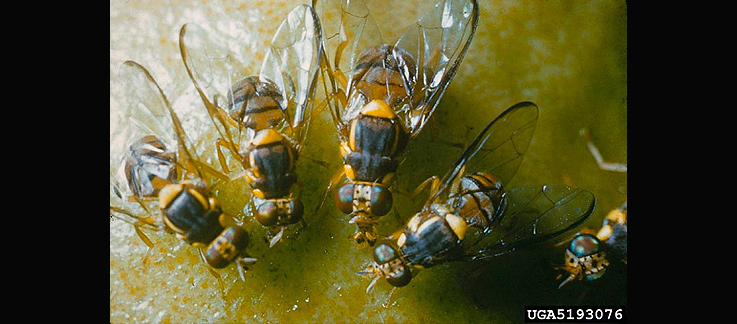This is a developing issue. Please check back regularly for more updates or follow here.
If you have questions about a fruit fly quarantine/eradication, or if you think you have fruits and vegetables infested with fruit fly larvae, call the CDFA Exotic Pest Hotline at 1 (800) 491-1899.
November 6, 2023, Update:
The Oriental Fruit Fly Quarantine Boundary has been expanded in San Bernardino and Riverside Counties.
See updated quarantine area here.
November 2, 2023, Update:
The MedFly Quarantine Boundary has been updated to include Los Angeles County – Leimert Park Area.
See updated quarantine area here.
From CDFA: The Mediterranean Fruit Fly (Med Fly) has one of the widest host range of any pest fruit fly, and is considered the most important agricultural pest in the world. It has been recorded infesting over 250 cultivated and wild fruits. The host list includes apple, apricot, avocado, bell pepper, carambola, coffee, dates, fig, grape, grapefruit, guava, lemon, lime, loquat, lychee, mango, nectarine, orange, papaya, peach, pear, persimmon, plum, pomegranate, pummelo, quince, sapote, tangerine, tomato, and walnut. See full list here.
Med Fly Fact Sheet here.
October 26, 2023, Update:
Portions of Ventura and Los Angeles Counties have been placed under quarantine for the Queensland fruit fly (QFF) following the detection of two adult QFFs within the City of Thousand Oaks, in Ventura County.
September 26, 2023, Update:
The California Department of Food and Agriculture has updated quarantine boundaries for the Oriental Fruit Fly in California to now include, Sacramento County (Rancho Cordova Area), Contra Costa County (Brentwood Area), and Santa Clara County (Santa Clara Area).
The Oriental Fruit Fly is known to target over 230 different fruit, vegetable, and plant commodities. Important California crops at risk include grapes, pome, stone fruits, citrus, dates, avocados, and many vegetables, particularly tomatoes and peppers. Damage occurs when the female fruit fly lays eggs inside the fruit. The eggs hatch into maggots, which tunnel through the flesh of the fruit or vegetable, making it unfit for consumption.
“Invasive fruit flies are serious pests for California’s orchards and backyard gardens,” said CDFA Secretary Karen Ross. “These recent detections remind us that we need to remain vigilant in protecting our food supply and natural resources. The stakes are enormous, and not just in California. A new report from the United Nations notes that invasive species management costs hundreds of billions of dollars each year around the world. We’re all in this together as we work to reduce this impact.”
Maps that delineate active quarantine boundaries can be found on the CDFA website.
This is a continuously updated post. This is an update to our previous post, Unusually High Exotic Fruit Fly Season in California.
Photo credit Florida Division of Plant Industry Archive, Florida Department of Agriculture and Consumer Services, Bugwood.org



